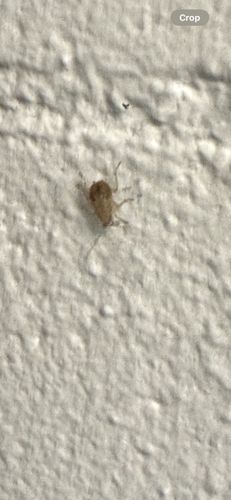Booklouse (or Psocid)
Scientific Name: Various species within Psocoptera (e.g., Liposcelis spp., although precise species identification is not possible from the image).
Order & Family: Order Psocoptera (also known as Psocodea); Family Liposcelididae (or other psocid families, identification to family level from image is difficult but it is certainly a psocid).
Size: Typically 1-2 mm in length, though some can be up to 10 mm. The one in the image appears to be on the smaller end of this range.

Natural Habitat
Booklice prefer damp, warm, and humid environments. They are commonly found indoors in homes, libraries, warehouses, and other buildings. They thrive in areas with high humidity, such as bathrooms, kitchens, and basements, or in stored paper products and dried foods.
Diet & Feeding
Booklice typically feed on microscopic mold, fungi, starch, grains, and various organic matter. They are especially common in areas where these food sources are available, such as old books, wallpaper glue, and stored food products.
Behavior Patterns
Booklice are generally harmless and are often found in damp, humid conditions. They are attracted to mold and fungi that grow in such environments. They can reproduce rapidly under favorable conditions. They are not known to bite humans or pets.
Risks & Benefits
Potential risks include being a nuisance pest, especially when present in large numbers. While they do not transmit diseases or bite, their presence can indicate dampness and mold issues in a building. They can also damage sensitive materials like books, paper, and food products by feeding on mold growing on them. There are no significant known benefits.
Identified on: 8/22/2025